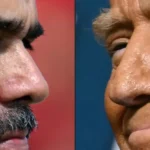
According to Beijing, he elevates global bags, but does not yet resolve bureaucratic barriers or guarantee effective exports of strategic resources
In an important movement in the international commercial scenario, the United States and China announced on Friday the completion of an understanding negotiated last month in Geneva. The information was confirmed by US Secretary of Commerce, Howard Lutnick, who also highlighted the White House immediate plans to firm agreements with a select group of ten of his main business partners.
The agreement between Washington and Beijing, signed two days ago, formalizes commitments established during recent negotiation rounds. One of the central points of the pact is the Chinese commitment to export rare land – essential minerals for the manufacture of products as varied as wind turbines, military aircraft and advanced electronic equipment.
“They will give us rare land,” Lutnick told Bloomberg News in an exclusive interview. “And as soon as this happens, let’s remove our counterproductive measures.” The statements signal an attempt to build mutual confidence after years of commercial tension between the two largest economies in the world.
The White House confirmed that the terms of the agreement aim to implement the understanding achieved in Geneva. However, Chinese representatives kept silent about the announcement: the China Embassy in Washington declined to comment, while the Ministry of Foreign Affairs in Beijing did not respond to a request for commentary until the closing of this edition.
The news immediately reverberated in the financial markets. Asian scholarships recorded appreciation, followed by future European, with the global stock index reaching another historical mark. Part of this optimism reflects the perception that US and China are walking to reduce commercial barriers, at least in some strategic sectors.
The new agreement emerges as an important milestone, considering that, on several occasions, the two countries have exchanged mutual accusations of non -compliance with informal commitments. Despite representing an advance, the understanding still depends on the realization of specific actions by both parties, especially the effective export of rare land by China.
In addition, Lutnick revealed that President Donald Trump is ready to seal a series of commercial agreements in the coming weeks. The focus is on July 9, the deadline set by the president to resume higher rates on various imported products if countries do not reach an agreement before that.
“We will close the top 10 agreements, classify them properly, and then the other countries will follow in this sequence,” Lutnick explained in statements to Bloomberg Television. However, he did not specify which countries will be included in this first group. In separate comments, Trump suggested that the US is close to closing an agreement with India, another strategic partner.
An Indian delegation led by the main negotiator, Rajesh Agarwal, should visit Washington this week to try to resolve pending and seek convergences. At the same time, Japan also prepares a new round of conversations. Japanese chief negotiator Ryosi Akazawa said before traveling to the US that Tokyo will not accept 25% car tariffs, one of the main US requirements.
On Friday morning, in Tokyo, Japan’s Chief Secretary of Civil House, Yoshimasa Hayashi, briefly commented on the issue. Although he recognized the possibility of new trade agreements involving the US, he avoided speculation. “Japan and the US are currently discussing a series of tariff measures, and we will continue to strive for this subject by prioritizing it.”
Pressure agreements
President Trump has made it clear that if countries do not conclude negotiations until the given deadline, the US will unilaterally impose commercial conditions. According to Lutnick, countries will be divided into different categories on July 9, although the US government can still grant extensions to extend discussions.
“Those who have agreements will have agreements; and all the others who are negotiating with us will receive a response from us and enter this package,” said Lutnick. “If anyone wants to negotiate again, they are entitled to do so, but the tariff rate will be defined and we will continue with it.”
In early April, Trump announced reciprocal rates that could reach 50%, but suspended most of them for 90 days to allow negotiations. Even with this break, uncertainty remains the actual reach of these future agreements. Historically, commercial treaties demand years of detailed discussion – something that contrasts with the accelerated pace proposed by the current administration.
The agreement with China, although significant, is still limited in scope. It does not address complex issues such as the fight against fentanyl trafficking, nor does it fully resolve the difficulties faced by US companies seeking access to the Chinese market.
Tortuous way
The story behind the agreement reveals a troubled process. After a first round of negotiations in Geneva, which resulted in an initial reduction of tariffs, both the US and China accused each other of violating the agreed terms. New conversations in London last month helped restore dialogue, culminating in the current understanding, pending the final approval of Trump and Chinese President Xi Jinping.
According to Lutnick, retaliatory measures imposed by the US before conversations in London will only be revoked when China begins to export rare land materials. Restrictions include bans or limitations on ethane export (raw material for plastics), chip software and aviation-related technology.
In this context, the US Department of Commerce recently announced a partial change in the export rules to China. Energy companies can now charge gas on tanker and send it to the Asian country as long as they do not unload without prior permission.
Despite this opening, according to reports from Bloombergsome American companies still await the definitive release of shipments by the Chinese authorities, which shows that bureaucratic barriers persist, even with the climate of commercial distension.
Meanwhile, the world carefully watches the next steps. Markets bet on temporary relief on commercial tensions, but experts warn that structural challenges between large powers will continue to shape global dynamics for a long time.
Source: https://www.ocafezinho.com/2025/06/27/eua-e-china-assinam-tregua-em-meio-a-promessas-frageis/

